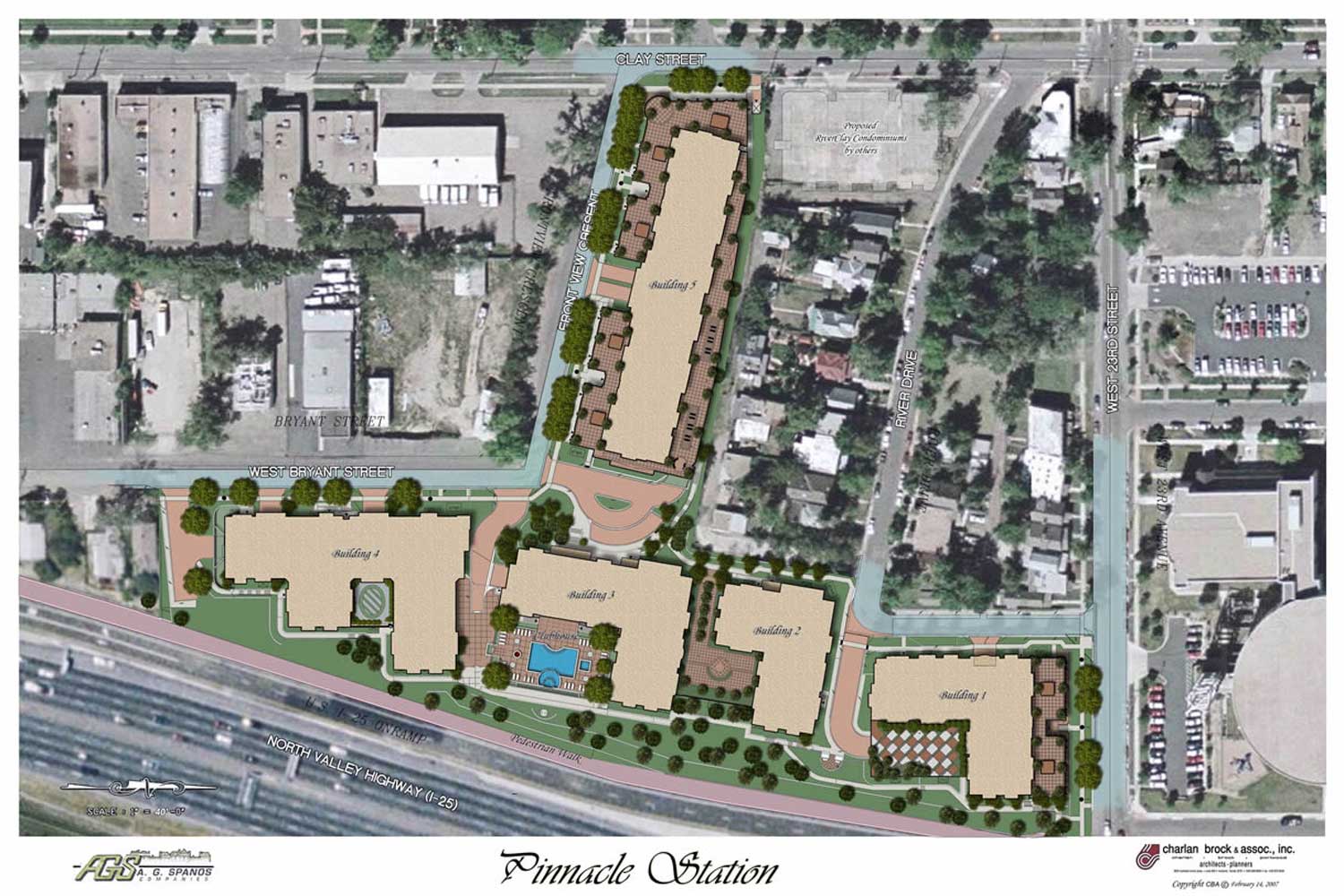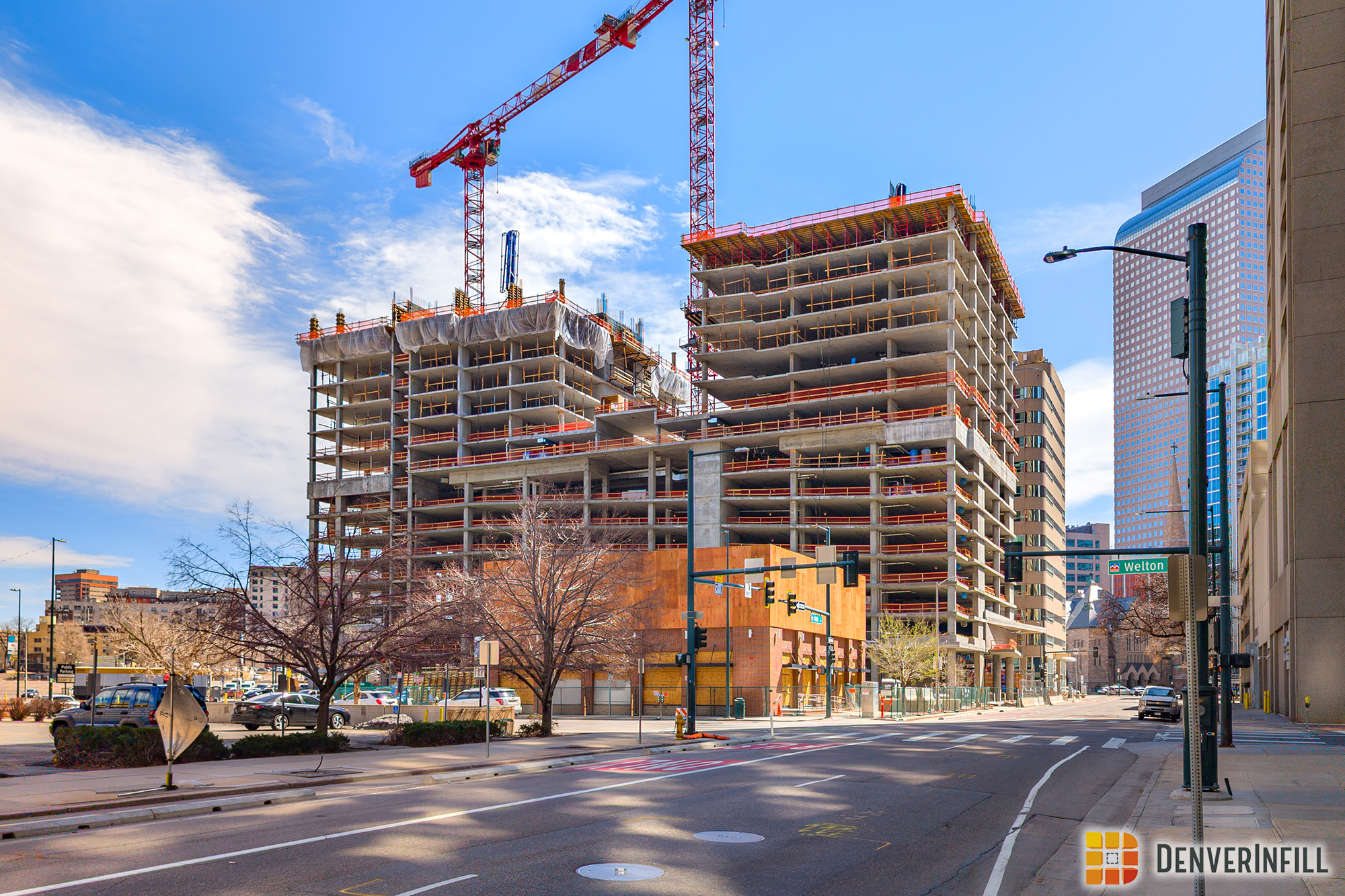The Pinnacle Station project proposed for the Jefferson Park neighborhood by the AG Spanos Corporation is on the verge of approval by Denver City Council.
Pinnacle Station is a 340-unit, five-building apartment project planned for the site of the old Baby Doe’s and Chile Pepper restaurants overlooking I-25 just north of Mile High Stadium. Many residents in the Jefferson Park neighborhood have opposed the development since its introduction over two years ago, claiming that the project’s massing is out of scale with the adjacent area, and that the project fails to incorporate a number of design and programmatic elements that are called for in the Jefferson Park neighborhood plan. The neighborhood association, Jefferson Park United Neighbors (JPUN), has voted overwhelmingly against this project three times in the past two years. For additional background information on this project, check out my blogs of October 11, 2005, March 14, 2006, and June 14, 2006. Also, Westword recently featured a nice article on the subject by Joel Warner (Moving On Up) along with a recent follow-up (Contested Development) by Joel in the Westword blog.
The project went before City Council on final reading last Monday, and included a lively four-hour public hearing. In the end, Council decided to delay their vote on approving Pinnacle Station by one week. One of the many concerns raised by neighborhood residents involved the shadows that the project will cast on several small homes along the alley behind River Drive. Council asked the developer to prepare a detailed shadow study and present it at next Monday’s meeting. While JPUN will not have a chance to independently verify the developer’s analysis, the city planning office will give the shadow study a review and offer its opinion as to the study’s validity.
Here are the latest renderings of the project. First, the site plan:
Building 5, from Clay Street looking down Frontview Crescent:
The “view corridor” at Frontview Crescent and Bryant Street between Buildings 3 and 4:
I’ve gone on record as being opposed to this project, and today I’ll state my reasons one more time. Just like JPUN, I support the redevelopment of the site. The two restaurant buildings have seen better days, and the time has come for a higher and better use for the site. I am certainly not anti-urban development. But the larger the project and the more prominent the location, the more important it is that the project be exceptional. Pinnacle Station is anything but.
New infill projects in the Downtown area, particularly ones of this size, should be urban. Urban means mixed uses. Besides its 340 residential units, Pinnacle Station has a measly 4,000 SF of retail and a few live-work units, and the developer recently added those to their plans only after being pressed to do so by JPUN. The neighborhood asked for 12,000 SF of retail.
Urban means a mix of rental and for-sale units. Pinnacle Station is 100% rental. Jefferson Park already has one of the lowest home ownership rates in the city. With the addition of Pinnacle Station’s 340 rental units, the Jefferson Park neighborhood will be about 95% rental. The developer has refused to incorporate any for-sale units in the project.
Urban means mixed income. Pinnacle Station will be 100% “luxury” apartments. Because the project is rental and not for-sale, the city’s 10% “affordable units” requirement does not apply. The developer has refused to provide for any affordable/workforce housing units in the project.
Urban means variety in the form and scale of the buildings. Pinnacle Station features five monolithic buildings that have “suburban” written all over them. The proposed buildings do not vary in their form and scale, nor do they relate to the surrounding urban context. The project site borders River Drive and West 23rd Avenue, both of which feature small, historic houses. A good design would respect the small scale of these historic homes by placing townhomes, rowhomes, or shorter multi-family buildings adjacent to them, and then placing taller, higher-density buildings along Bryant on the bluff overlooking the expressway. The developer’s plans call for a six-story building (Building 5) that is over 400 feet long to border the little historic homes along River Drive. To be fair, I must point out that the developer has recently modified the design of Building 5 (in response to the neighborhood’s concerns over this issue), and the modification is not reflected in the rendering above. The design change takes the four-story upper part of Building 5 and divides it into two masses, separated by a 25-foot gap. This will visually help break up the massive appearance of Building 5, but it doesn’t do much to address the lack of compatibility in scale to the adjacent single-family homes. Building 5 is also the subject of the shadow study discussed above.
The neighborhood association offered an alternative plan, shown in the sketch below, which addresses many of the issues I’ve been discussing. Take a look:
Unfortunately, the developer dismissed the neighborhood’s proposal.
The AG Spanos company is a suburban developer. Take a look at their project portfolio on their corporate website. I randomly picked about a dozen of their “communities” and viewed their locations and urban context using Google Earth. Not a single one of them was in a downtown location. Most of them, in fact, were located in exurban areas, bordered by large undeveloped tracts of land, shopping malls, office parks, and freeway interchanges. The Spanos project closest to a downtown that I could find was in Houston, and it was still five miles away from Downtown Houston and is in what looks like a commercial area.
Spanos has a suburban design template, and they make their money by replicating that template, with as few changes as possible, over and over again. Find a big suburban site, plop down their automobile-oriented “luxury community” and move on to the next location. That’s what they do, and that’s exactly what they’re doing here. The problem is, Jefferson Park is not on the exurban edge but on the edge of Downtown Denver.
There are other infill projects that have been built recently in the Downtown area that are similar to Pinnacle Station, such as the Metro in the Prospect district or the Jefferson at CityGate project in River North. But those projects are located in industrial areas that do not have historic single-family homes next door, and they don’t have the prominent “overlook” location like the Baby Doe’s/Chile Pepper site.
This entire Pinnacle Station project is a major missed opportunity. Given the historic character of Jefferson Park, the proximity of the site to the Downtown Aquarium, Elitch Gardens, Invesco Field at Mile High, and the rest of the amenities of the Central Platte Valley, and the panoramic views from (and of) the site, this development should have been held to the highest of standards. This project could have featured both condos and apartments in a wide variety of sizes and price ranges, in an architecturally-diverse collection of urban townhomes, low-rises and mid-rises, and integrated with a cool public plaza overlooking Downtown bordered by ground-floor shops and restaurants. It could have, but it doesn’t.
Kudos to Jefferson Park United Neighbors for putting up the good fight and demanding excellence in the development of our urban core. Too bad they fought this battle alone. The city really dropped the ball on this one.














…and now, almost two years later, how things have changed! Things are looking up in Jefferson Park. Our new neighbors are energetic and involved, and bring many talents to the table. Spanos has recently presented JPUN with another design from another architect, much scaled down and neighborhood-friendly, quite reasonable actually, but let's see if the money to do this actually comes together. Sounds like projects currently under construction are going to finish but as yet unbroken ground is going to have a tough time. The fox and wildlife preserve of the former Baby Doe's is not such a bad thing…we still have our view!